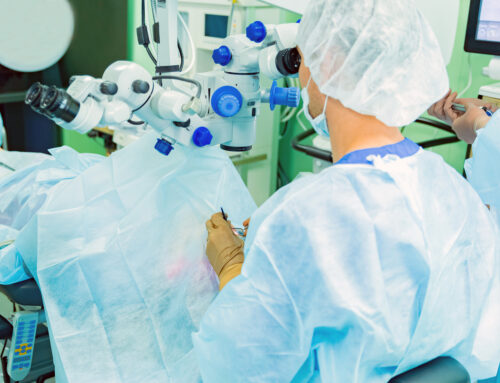Intraocular lenses (IOLs) became a routine step in cataract surgery around 70 years ago. Since that time, there have been two parallel journeys towards perfecting the process. (1) The process of getting the natural lens out and (2) replacing it with a customized IOL for clear vision. We’re skipping the first part (getting the natural lens out) because people find it gross and it’s not our topic today.
The Customized IOL
Today we’re talking about the relatively recent and miraculous advancement made in the second category: dialing in a customized IOL to provide clear, no-glasses vision. It’s called the light adjustable lens. We waited so long for it to get here, because it was going to be an absolute game changer in IOL technology. I honestly still kind of can’t believe it’s real and it’s every bit as good as we hoped.
Since the dawn of IOLs, we’ve had the vexation of trying to get the correct power IOL in each eye. They were terrible at it originally, and had good reason to be since every eye needs a specific power. The catch was (and still is!) you can’t know exactly what power each eye actually needed until about a month after the procedure.
That means if you check the prescription a month out and it’s zero, you nailed it! If you check the prescription and it’s not zero (either myopic, hyperopic and/or with astigmatism) then, well, you didn’t nail it. Problem is, now the IOL is already in there. And since IOLs are designed to stay put, the risk of replacing it usually outweighs the benefit. Because the alternative is the extremely safe (albeit annoying) option of glasses.
How It’s Calculated
Luckily, IOL calculations done before surgery are really amazing now. Interestingly enough, your current glasses prescription hardly matters. Instead, it’s calculated by a bunch of different measurements (with 0.01 millimeter levels of accuracy) of the eye, which get plugged into different proprietary formulas. Since we’re on the 5th generation of those formulas, they’re pretty good. Except there’s an issue.
Some eyes are outliers. Super accurate measurements, the best proprietary formulas, perfect surgery… and we find out a month later the eye didn’t get the memo that “yes, this is the correct IOL power.” Or at least it should have been.
That’s why the availability of LASIK has been so helpful. We don’t need it very often, but when someone wants to be glasses free and they aren’t quite there, it’s a nice safety net to have. Sometimes, however, LASIK isn’t an option. There are different reasons that might be the case, but the most common is because of some pre-existing condition that we know about beforehand.
In those cases, how wonderful it would be to have a magic wand that we could wave and nudge the IOL power to be the correct one. And now – glory, glory! – we have that magic wand. Light adjustable lenses (LALs) are designed in a way that lets us change the prescription power after it’s in the eye. We still do all the same measurements and calculations to pick the right power. It’s still the same 10 minute procedure to place the IOL. But instead of the first draft = final draft restriction we’ve had for 70 years, we finally have an “edit” option.
How It Works
The LAL is made of a material that responds to a specific wavelength of UV light. It changes the contour of the IOL and that changes the focusing power. It can be modified in whatever way necessary, more or less near or far sighted. It even corrects astigmatism. Once the prescription is dialed in just right, it is “locked in” so that UV light can’t and won’t change it ever again.
The UV light is delivered during a post-op clinic visit by a Light Delivery Device (LDD). The LDD costs about a bazillion dollars and the price tag makes sense. Imagine a device that can precisely deliver a specific wavelength of light on a scale measuring accuracy in thousandths of a millimeter. It’s mind blowing how smart some people are. I bet the inventors of the LDD require custom-made hats because normal hats don’t fit their huge craniums.
The idea was just a fantasy for a decade even though the science of modifying polymers with UV light has been around much longer. The math calculating the correct curvature change and precision involved in implementing it seemed impossible. And yet, here we are. For the first time since the invention of IOLs, we can fine tune vision accurately and reliably when it’s most helpful – after we know what changes are necessary. What a time to be alive!




